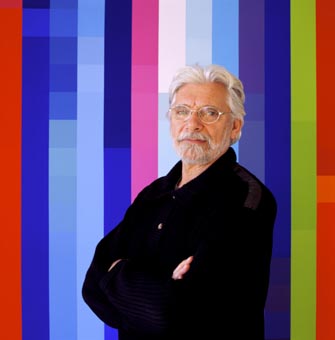< Return
Robert Owen: Different lights cast different shadows
Art Gallery of New South Wales
Saturday 16 October - Sunday 28 November 2004

- The second Balnaves Foundation Sculpture Project -
An exhibition of selected work created over more than 10 years by senior Australian artist Robert Owen is this year's Balnaves Sculpture Project at the Art Gallery of New South Wales. This exhibition focuses on the connections between Owen's often rigorously minimal sculptural practice and his richly coloured and emotive abstract paintings.
Robert Owen has been an exhibiting artist for over forty years. His art practice during this time has been characterised by the use of diverse materials and approaches that are linked through a poetic sensitivity to the expressive potential of materials, light and colour, and through an almost scientific interest in geometric form and grid variations in both sculpture and painting.
This exhibition is the second of the series of five sculpture projects at the Art Gallery of New South Wales made possible with a five year commitment made by Neil and Diane Balnaves through the Balnaves Foundation. The inaugural project was the exhibition Still Life last year.
For this exhibition Robert Owen is creating a major new sculptural work, Tears of History. The Astral black granite floor sculpture is a distillation of what the sculptor regards as the sorrows of recent Australian history and particularly race relations. It is exhibited with the recently completed suite of abstract paintings Transitions of night (Lake Mungo), 1999-2004, whose dark tonalities provide an evocative counterpoint to the intensity of the floor work.
Owen is also creating a new large scale luminously coloured wall painting at the entrance to the exhibition, a development of his Sunrise exhibition from the early 1990s. Dominating the gallery next to this painting is Owen's Vessel #2 (Blue), 2003, from the series Cubes and Hypercubes. This enormous abstract sculpture is one of the largest manifestations of Owen's Hypercube series which can be seen in many other forms in the exhibition: wall drawings, floor and wall sculptures, and in dozens of carefully mapped variations of this geometric proposition which has fascinated Owen over the last decade.
Recent sculptures from the Hypercube series are exhibited in the final room of the exhibition along with Owen�s magnificent painting Cadence #1 (A short span of time) 2003, exhibited here in its complete version for the first time. Owen had over 2000 colour tones mixed in order to be able to chart the variations of his emotions over a 64-day period.
Exhibition curator, Wayne Tunnicliffe, Curator of Contemporary Australian Art at the Art Gallery of New South Wales, says, "Robert Owen's sculptures are integral to his art practice. Sculpture has been the point of departure from which his unique contribution to Australian culture over forty years has developed. In the last decade the richly expressive science of his use of colour in painting has echoed the poetic geometry in his exploration of sculptural form."
Robert Owen studied sculpture at the National Art School under Lyndon Dadswell and graduated in 1962. After spending time in the Greek Islands and in London in the 1960s he returned to Australia in 1975. In 1978 he represented Australia at the Venice Biennale. He exhibited widely in both solo and group exhibitions through the 1980s and 1990s. During this time he has also undertaken many public sculptural commissions, including most recently the Webb Bridge project with architects Denton Corker Marshall for the Melbourne Docklands. In 2002 he received an Australia Council Emeritus Award for life-long service to the arts. This is Robert Owen's first major Sydney solo exhibition since 1994.
Exhibition Talk - Saturday 16 October 2pm
Robert Owen and Wayne Tunnicliffe in conversation: Join artist Robert Owen and exhibition curator Wayne Tunnicliffe on a walk through the exhibition.
Level 2, Art Gallery of New South Wales
Free, no bookings required.
IMAGE:Portrait of Robert Owen with Cadence # 1 (a short span of time)
Photo credit: � Earl Carter |